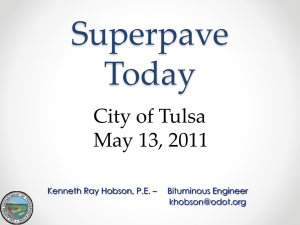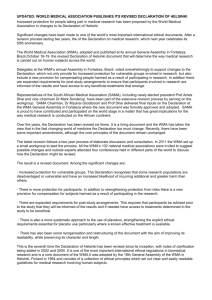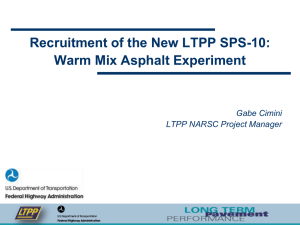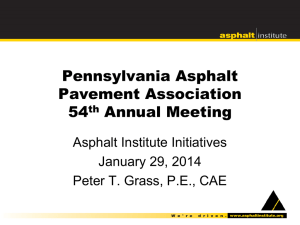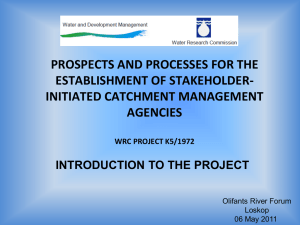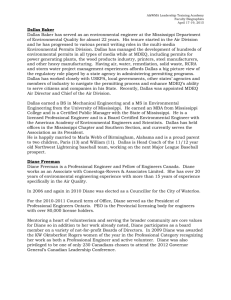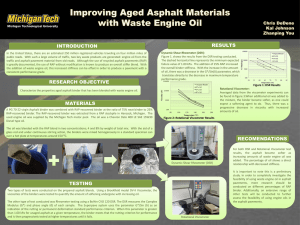March 26, 2012 Steering Committee Meeting Minute
advertisement
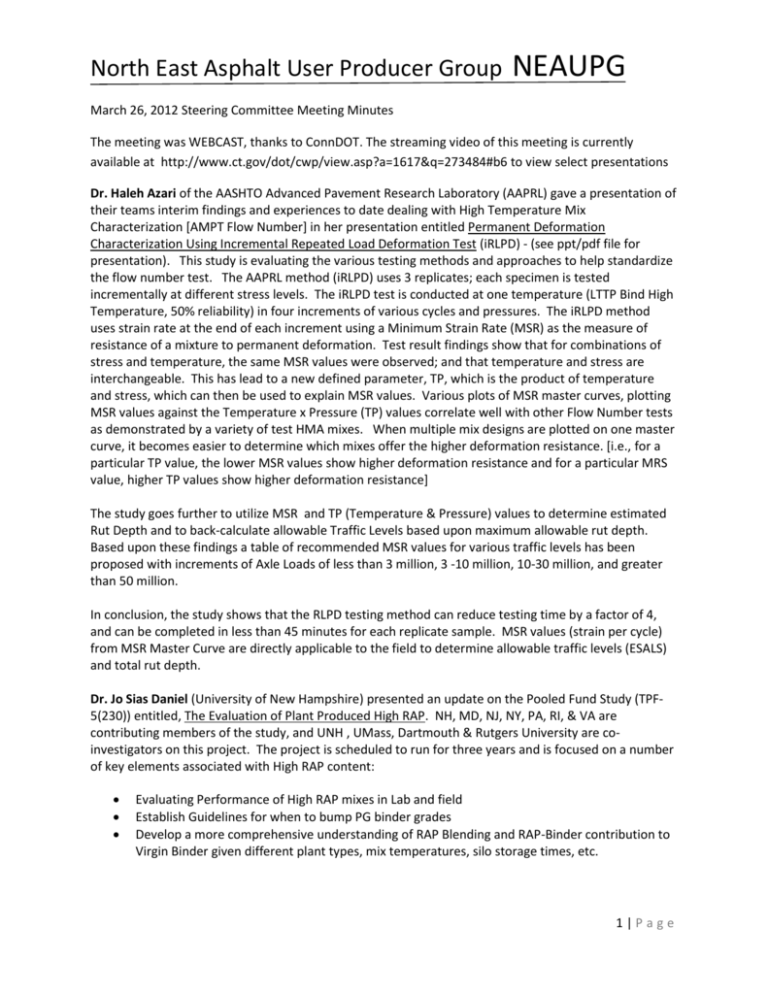
North East Asphalt User Producer Group NEAUPG March 26, 2012 Steering Committee Meeting Minutes The meeting was WEBCAST, thanks to ConnDOT. The streaming video of this meeting is currently available at http://www.ct.gov/dot/cwp/view.asp?a=1617&q=273484#b6 to view select presentations Dr. Haleh Azari of the AASHTO Advanced Pavement Research Laboratory (AAPRL) gave a presentation of their teams interim findings and experiences to date dealing with High Temperature Mix Characterization [AMPT Flow Number] in her presentation entitled Permanent Deformation Characterization Using Incremental Repeated Load Deformation Test (iRLPD) - (see ppt/pdf file for presentation). This study is evaluating the various testing methods and approaches to help standardize the flow number test. The AAPRL method (iRLPD) uses 3 replicates; each specimen is tested incrementally at different stress levels. The iRLPD test is conducted at one temperature (LTTP Bind High Temperature, 50% reliability) in four increments of various cycles and pressures. The iRLPD method uses strain rate at the end of each increment using a Minimum Strain Rate (MSR) as the measure of resistance of a mixture to permanent deformation. Test result findings show that for combinations of stress and temperature, the same MSR values were observed; and that temperature and stress are interchangeable. This has lead to a new defined parameter, TP, which is the product of temperature and stress, which can then be used to explain MSR values. Various plots of MSR master curves, plotting MSR values against the Temperature x Pressure (TP) values correlate well with other Flow Number tests as demonstrated by a variety of test HMA mixes. When multiple mix designs are plotted on one master curve, it becomes easier to determine which mixes offer the higher deformation resistance. [i.e., for a particular TP value, the lower MSR values show higher deformation resistance and for a particular MRS value, higher TP values show higher deformation resistance] The study goes further to utilize MSR and TP (Temperature & Pressure) values to determine estimated Rut Depth and to back-calculate allowable Traffic Levels based upon maximum allowable rut depth. Based upon these findings a table of recommended MSR values for various traffic levels has been proposed with increments of Axle Loads of less than 3 million, 3 -10 million, 10-30 million, and greater than 50 million. In conclusion, the study shows that the RLPD testing method can reduce testing time by a factor of 4, and can be completed in less than 45 minutes for each replicate sample. MSR values (strain per cycle) from MSR Master Curve are directly applicable to the field to determine allowable traffic levels (ESALS) and total rut depth. Dr. Jo Sias Daniel (University of New Hampshire) presented an update on the Pooled Fund Study (TPF5(230)) entitled, The Evaluation of Plant Produced High RAP. NH, MD, NJ, NY, PA, RI, & VA are contributing members of the study, and UNH , UMass, Dartmouth & Rutgers University are coinvestigators on this project. The project is scheduled to run for three years and is focused on a number of key elements associated with High RAP content: Evaluating Performance of High RAP mixes in Lab and field Establish Guidelines for when to bump PG binder grades Develop a more comprehensive understanding of RAP Blending and RAP-Binder contribution to Virgin Binder given different plant types, mix temperatures, silo storage times, etc. 1|Page North East Asphalt User Producer Group NEAUPG To date (after approximately 1 year from start), 18 HMA Mixtures have been evaluated. Primarily these 12.5 & 9.5 mm NMAS mixes came from three suppliers, representing both drum and batch plant production, using both a standard (PG64-22, PG58-28 or PG64-28) binder and mixes with companion softer binder grades of PG58-28 and PG52-34 respectively. All mixes are being evaluated for 0%, 20%, 30%, and 40% RAP content. One producer’s source is being evaluated to determine the change in mix characterization based upon silo storage times with both a control of 0% RAP and 25% RAP in increments of 0, 2.5, 5, 7.5 and 10 hours. The scope of this project is to fully evaluate both Recovered and Virgin Binder characteristics (PG Grade, master curves, Critical Crack Temperature, Asphalt Binder Cracking Device, and Softening Point testing). For each mix design, the laboratory evaluations included Complex Modulus, Hamburg & TSR testing, Low Temperature Creep & Strength testing, Fatigue testing using the Simplified Viscoelastic Continuum Damage (S-VECD) model. Current observations and findings from Phase I of this study shows that RAP has a measured impact to: increase І E*І, observed PG high temp grade bumps with RAP content above 20% and minimal impacts to low-temp PG Grade, observed differences in ABCD and CCT results, apparent a lab handling and reheating procedures can impact properties, and lastly it appears that production parameters such as discharge temperatures and silo storage times appear to have an impact on mix properties. Phase II will examine additional mixes from other sources and continue the silo storage investigation. During Phase II, Hamburg Testing and Workability (UMASS) device will be eliminated; however, additional tests such as Glass Transition Point, Overlay testing and TSRST and Beam Fatigue testing will be added. Asphalt Binder Subcommittee updates: Eileen Sheehy from NJDOT is on the AASHTO R26 subcommittee which is focused on the Certification of Suppliers of Performance Graded Asphalt Binders. Revisions are underway and she is looking for your comments no later than 5/1/2012. ACTION ALL: Get Comments to Eileen by 5/1/2012. EMAIL to Eileen.Sheehy@dot.state.nj.us Producer QC Plans remain the same for the 2012 season: most producers have a standard QC plan with state-specific addenda to address subtle differences in requirements. Discussion on whether the new Multiple Stress Creep Recovery (MSCR) [ref. AASHTO TP70 & AASHTO MP19] test results should be provided by producers as part of their QC plan, if nothing more than as a shadow tests procedure to start to become familiar with the new testing methods and Binder Grading methodology. Note: RIDOT is piloting the MP19 classification on all polymer modified asphalts (PMA) this year. The subcommittee anticipates hearing about the results at next year’s annual steering committee meeting. Some additional discussion on similar initial findings of trial MSCR testing is being conducted with the SEAUPG. Sideline discussion on whether the MSCR % Recovery curves should be included in TP70 and should they be included in MP19 (stepped vs curved function is another discussion point). Asphalt Institute is recommending the implementation of MP19 to replace the current PG Grade-Plus type testing approach via elastic recovery & stiffness gradation methods. Review of the participants indicates that most all State Binder Labs and all Producers labs have the MSCR capabilities. Note: Annual AMRL testing is now including the MSCR test results in their laboratory evaluation process. 2|Page North East Asphalt User Producer Group NEAUPG Sideline discussion on Solubility Testing, (I believe this is really a discussion on AASHTO T164, Quantitative Extraction of Asphalt Binder from Hot Mix Asphalt) where the extraction method can employ the use of Trichloroethylene as one of three potential solvents per test method standards. Normal-propyl bromide or methylene chlorides are alternatives, and there is a desire to move away from the Trichloroethylene to a naphtha-Toluene substitute. Asphalt Mix Subcommittee updates: Primary focus of subcommittee was on Warm Mix Asphalt (WMA) o Reviewed each states WMA status o Discussed some apparent changes to volumetric properties with some WMA technologies o Discussed status of WMA specifications and implementation of NEAUPG WMA Technology Approval Process and/or technology adoption approach, using NYSDOT’s WMA Technology Approved List. o The group expressed concerns with the need for a better definition of WMA to clearly define environmental benefits from that of HMA compaction aid applications. 50 degrees below normal HMA production temps is becoming the growing consensus amongst the group. o WMA and RAP/RAS is an emerging priority for the committee. o Volumetric mix designs for municipal work are another topic on the agenda for this subcommittee to address. Jim Mahoney – CAPLAB Pooled Fund Binder Equipment Purchase Status (report read by Jim Dunne ) I apologize about not being able to attend the Steering Committee Meeting, but I'm conducting a Binder Technician Certification course. 7 States participated in the pooled fund purchase (New England & New York). Funds for the purchase of the equipment have been received from all 7 States by ConnDOT. The funds from 5 of the States have been made available for UConn to use for the purchases. The remaining 2 States’ funds are moving within ConnDOT and should be available in near future. The CAP Lab has issued Purchase Orders for most of the desired equipment for the 5 States. NYSDOT has already begun to receive equipment as their funds were the first to become available. We are in the process of preparing the RFP for the Rotational Viscometer and will be working on a RFP for the Asphalt Binder Cracking Device. ACTION: State Representative – Get with Jim Mahoney if you have any outstanding issues. Mahoney@engr.uconn.edu 3|Page North East Asphalt User Producer Group NEAUPG Ron Corun, AMPT User Group Ron stated that Tom Bennert from Rutgers University is willing to chair a new AMPT User Group, based on the recent purchase of AMPT equipment by many (if not all) NEAUPG State members. This would provide a forum for any additional technician training needs, become a conduit for sharing and networking with other states, industry and academia, provide round robin evaluation of new equipment that will aid in establishing precision and bias evaluation on this equipment and would provide the ability to explore and implement new testing standards (Continuum Damage Fatigue-push-pull testing and Dynamic Modulus in IDT Mode testing). Most AMPT equipment (purchased through FHWA Pooled Fund Study) has been shipped, installed and initial OEM training has been conducted to most participating NEAUPG states. ACTION: Ron Corun to send out letter of intent/interest to all NEAUPG States, Industry participants and academic institutions to seek out commitments. It is also encouraged to contact Tom Bennert directly at [732-445-5376] or email him at bennert@eden.rutgers.edu and let him know your party’s interest and willingness to participate in this User Group. Frank Fee – MSCR Round Robin Testing Report-out At the 2011 annual steering committee meeting, Frank outlined the need for MSCR testing, which is a means of characterizing High Temperature Binders that is essentially blind to the type of polymer modification used. In this Inter-Laboratory Study (ILS) 27 labs participated [10 producers/11 users/ 6 generalists] by testing 4 PG Grades plus one RTFO sample. Data was independently analyzed by the Asphalt Institute. The test results will help to provide test standard precision and bias statements on various grades of asphalt. The test accomplishes two results; it helped end-users become familiar with the MSCR test requirements (for many, this was the first time running these tests), and secondly with the data collected we can now help to identify problem areas. The next phase to be executed this year will be to ask a handful of State Labs to run shadow tests on some Polymer Modified Asphalts (PMA), collect the data and fine-tune the test standard, equipment and/or calculations. The ultimate goal is to standardize on this test and get away from “Plus-Spec” testing requirements enforced on suppliers. It looks very promising for the full range of current and future asphalt modifiers. During 2011, NJ, DE, PA, MD and NY conducted shadow MSCR testing on PMA binders. In April of 2011, shortly after our last steering committee meeting, the ILS study was forwarded to all participants. Also, since our last meeting, FHWA has produce a Technical Brief [FHWA-HIF-11-038] on the Multiple Stress Creep Recovery (MSCR) Procedure that can be downloaded at: http://www.fhwa.dot.gov/pavement/materials/pubs/hif11038/tb00.cfm Frank shared with the group the similar MSCR study finding being conducted at the SEAUPG. The concern during the National Binder ETG discussions, and echoed by many of the NEAUPG State representatives conducting MSCR testing, is with repeatability of the test with softer binders. Frank emphasized a goal of trying to consider allowing suppliers to certify binders based upon MSCR (AASHTO MP19) test standards; thereby providing shadow grading for informational purposes with percent recovery stated for PMA binders only. Sideline discussion with industry representatives suggests that most producers have already been conducting pilot studies of their own to see how their products grade out under this method. 4|Page North East Asphalt User Producer Group NEAUPG ACTION: The NEAUPG Binder Subcommittee will formalize a proposal and paper ballot vote, which will be sent out to all NEAUPG State Representatives, which will propose that suppliers conduct MSCR testing as a shadow test and report out using new Binder Grading system on the COA for the remainder of the 2012 season. Note: Frank is officially retiring from NuStar Asphalt as of May 1, 2012 and will continue his industry involvement under the name of Frank Fee, LLC. Jim Dunne NEAUPG/NESMEA Financial Status Jim gave a quick run-down on the financial status of both NESMEA/NEAUPG...bottom line is that NEAUPG has approximately $45,000 balance, and on top of that has an approximate $30,000 held in reserve for the NESMEA group. Alan Rawson- Joint NESMEA/NEAUPG Administrative Manager Proposal At the last NEAUPG Steering committee meeting, the group voted to accept an annual payment of $5,000 from the NESMEA organization which would be used to fund a Joint NESMEA/NEAUPG Administrative Manager position that would cover the Event Planning activities, financial and organizational record keeping and providing technical assistance where necessary to achieve yearly organizational promotional workshops, committee meetings, annual technical conferences. The current Joint NESMEA/NEAUPG Administrative Manager position has a current salary under NEAUPG of $17,000 per annum. Based upon the additional $5,000 coming to this group from NESMEA, a formal proposal was made to increase the salary for this position to $22,000 per annum. Motion seconded to increase the salary to $22,000. Discussion: Bruce Barkevich strongly encouraged future NESMEA/NEAUPG Annual Technical Conferences to utilize the expertise and in-place state-specific organizational structure and network offered by the host State Asphalt Paving Association to help defray some of the event organizational costs for such things as mailers, orchestrating registration, collection of registration fees, on-site registration and badging, on-site vendor registration and display layout/coordination, etc. Vote: voice vote, unanimous yes, Proposal Passes. Russ Thielke – Bill of Lading Discussion Continued from 2011 The focus of our 2011 meeting discussion centered on receipt of terminally blended products at Asphalt Production Plants and assisting end-users in defining what’s in the delivery tank. Russ annotated key differences between Modifiers (which modify the PG grade) and additives (PG Binder with additive which changes binder engineering properties), the latter of which include most terminally blended capable WMA (additive/chemical-type) Technologies. Ideally, somehow, end-users would like to see some description of “Additive”, what technology and its supplied dosage on the BOL. The NEAUPG members felt comfortable not being too prescriptive on how this is to be accomplished, and will leave it up to each shipper to decide for themselves how this will be accomplished. Those present representing industry stated that it can be a $5,000 item to bring in a programmer to add another field or drop-down selection window in their current BOL programs. Many stated that they would just add text to the item description field, such as PG64-22 w/0.5% Evotherm as a means of satisfying this request. 5|Page North East Asphalt User Producer Group NEAUPG Russ queried the State representative and producers present to see if any outstanding issues were problematic – None were stated – Implementation success. Russ Thielke – NEAUPG WMA Qualified Product List Status Update Russ reported that two more WMA technologies would be added to the list this week, bringing the total of Approved WMA technologies up to 11 technologies approved for use. It was suggested that an email list of all State DOT representatives who are the key contact in their state for WMA be developed. This list could help to share emerging information and to curtail the WMA technology providers, who don’t get the answer they are looking for, to go shopping sister states until they get the answer they want. To date, NYSDOT has experience a few of these and the process is working. Most of them were referred back to the NEAUPG WMA Approval Process. The group was also interested in knowing the potential approval status of other WMA Technology providers whose approval status maybe “in-process”. This illustrates another example of how the email list could be used to share this type of information. ACTION: Alan Rawson/Russ Thielke to develop WMA key contact list for WMA for each NEAUPG state. ACTION: UPDATE NEAUPG Website with all approved WMA technologies to date. It should be remembered that this approval process is only a year old, and at the time of implementation other states, such as PennDOT had a previous WMA technology approval process prior to the NEAUPG Approval Process; hence, technology providers may see subtle differences amongst approved technologies adopted by states. State Specific Experience with WMA- General Discussion Maine: Not much experience with true WMA...has used some technologies (Sasobit, SONNEWARMix™, and Advera) for HMA compaction aids. DOT is willing to do some HMA/WMA substitution on a projectby-project evaluation basis. Connecticut: WMA is fully institutionalized in their Maintenance Paving Program. CTDOT has a Longitudinal Joint Density Specification Requirement with the wedge joint still giving contractors a problem, hoping WMA will help. In 2012, will have 5 paving contracts with WMA specified on Interstates. In 2013, they are going with wholesale adoption of NEAUPG WMA Approved Technologies. Massachusetts: 50% of paving program is WMA. Mass-Turnpike has 2 large paving contracts which have WMA specified. MassDOT is really pushing Asphalt production temperature reductions due to legislative requirements to quantitatively reduce Green House Gases at the project level. New York: Starting in 2012, now allowing WMA substitution as a “no-cost” option on all HMA paving projects. Production and compaction temps are being monitored per WMA Technology provider specifications. Experience is showing that WMA foaming technologies do not give you the beneficial characteristics in cold weather conditions and/or long-haul distance to project. 6|Page North East Asphalt User Producer Group NEAUPG New Hampshire: Approximately 33% of all HMA paving projects are now WMA. Most are foaming technologies; some technologies are being employed as HMA compaction aids. Two Maintenance Paving Contracts were formally defined to utilize specific non-foaming WMA technology. In 2012, NHDOT will be experimenting with 40% RAP in a WMA mix design...this is also a FHWA Highways for Life funded project, so we may have an opportunity for a project demonstration during laydown. New Jersey: Fully implemented WMA permissive specification. Have experience with WMA technologies being used as a HMA compaction aid during cold weather production/placement. In 2011, NJDOT complete 2 WMA projects. In 2012, will be requiring WMA technology specific (foam or additive) on most paving projects. Whenever NJDOT uses crumb rubber, WMA technology is employed. Delaware: Approximately 38% of all tonnage is with WMA technology utilized, primarily foaming, Advera. Experiencing production mix temperatures getting lower; however, not down to 50 degrees below HMA production temperatures yet. Good experience in utilizing WMA technology during cooler weather production and able to meet compaction specification. Maryland: Approximately 40-50% of all tonnage is WMA, predominately foaming technology, but with minimal temperature reductions; primarily production temperatures are ranging around 275-285 F. Pennsylvania: PennDOT uses the NYSDOT/NEAUPG WMA approved list like the NTPEP program. The NTPEP program provides data that the state can use in its decision to approve products. PennDOT has an existing product approval process in place that still needs to be followed for all products including WMA Technologies. As part of the PennDOT Product Approval process, PennDOT is currently requiring all PennDOT unapproved WMA Technologies to conduct one (1) pilot project in PA so that we can collect data and gain experience with the WMA Technology in our own state. We just feel that this is important at this point. We don’t require that they be on the NYSDOT/NEAUPG approved list either. Additionally, the PennDOT approved list of WMA Technologies currently includes 13 WMA Technologies with two other technologies at the point of seeking a PennDOT pilot project. As mentioned during the Binder Committee Meeting today, it was indicated that the NYSDOT/NEAUPG list only includes 8 or 9 WMA Technologies. Also, for WMA Technologies that can be blended at the refinery/terminal, PennDOT is requiring that the refinery/terminals submit for approval so that PennDOT knows what they are intending to supply (project documentation issue and approved source of supply issue) and to ensure that their QC plans address the blending of the WMA Technology (type, dosage, documenting on BOL, and its affects, if any, on the specified PG binder grade from the source). General Observation – on state implementation of WMA technologies...Excellent demonstration of how NEAUPG, through the orchestrated multi-state cooperation to develop and adopt a WMA Technology Approval Process early in the implementation phase, has demonstrated benefits of this much implementation in just one year. Hat’s off to Alan Rawson (NHDOT) for leading this effort. HMA/WMA Plant Producers comments: 50 degree reduction in production with WMA achievable, 30 degree reduction achievable with foaming technologies. Good experience with Rubber and WMA additive during late season paving. 7|Page North East Asphalt User Producer Group NEAUPG On the question “will state DOT’s require WMA additive during emergency low-temp (cold weather) paving?” NJDOT stated that they are considering requiring a WMA additive if paving temperatures drop below 40 degrees. It was brought up that North Carolina DOT allows the addition of WMA additives to be used in lieu of the required anti-strip agent. PENNDOT is evaluating this approach also. Ron Corun – Rubber (CMCRA-Terminal Blend vs Modified Rubber [rubber modified at the HMA facility] vs Asphalt Rubber per ASTM D6114 specification – General Discussion Ron made a presentation on the challenges currently presented to accurately grade the post-blended PG binder due to crumb rubber particles size potentially exceeding the 1mm gap requirement on the DSR parallel plates. The Binder ETG is expected to modify the standard at the next AASHTO SOM meeting to increase the DSR gap to 2mm. Alternative test methods such as ‘cup and bob’ are being explored; however, the DSR modification has much more momentum for approval. Discussions with State representatives suggest that we could potentially see more rubber blending in the near future due to increase pricing of SBS polymer modifier. Some discussion on rubber fine gradation (250 micron particle size, 50 mesh). NJDOT and MassDOT have experience with usage of rubber modification on OGFC and other gap-graded mixes...it is the binder of choice in these applications...currently ASTM specified, not PG graded. The group recommended that this may be an excellent topic for the upcoming Annual NEAUPG Technical Workshop in the fall, possibly defining the differences between DSR, Cup & Bob, ASTM Spec vs PG grading, etc. ACTION: Ron Corun. Ron Corun – Recycled Asphalt Shingles (RAS)– State & Industry Experience: General Discussion Ron shared with the group the national experience with RAS mix designs and the differences experienced with Manufactured Waste (softer asphalt) versus post consumer tear-offs (oxidized and stiff asphalt). Obviously, apparent challenges include the potential for higher production temperatures when incorporating post-consumer tear-off RAS. Asbestos contamination remains an outstanding issue with post-consumer tear-offs with many states now requiring shingle grinding/processing firms to become licensed/certified to conduct hazardous waste monitoring. The typical limitation on RAS content in the mix is 3-5% by weight. RAS typically contains 20% asphalt, so the asphalt contribution to a mix form 3% RAS is about 4 times greater than a typical RAP mix with 5% asphalt content, or about 12% asphalt contribution to the mix. Delaware: One shingle manufacture in state, no post consumer tear-offs allowed in mixes, requires continuous plant monitoring, currently limited to use in WMA mixes and has closely monitored production temperature limitations placed on production. New Hampshire: Shingle suppliers are constantly monitored for asbestos. NHDOT allows up to 0.6% binder contribution by any RAS. The post-blended binder must meet Regional Grade of Binder requirements, using the extraction method. Gradation of RAS is critical. Special specification is in place; however, there have been no projects to date that have incorporated RAS. NHDOT has a Binder replacement specification. 8|Page North East Asphalt User Producer Group NEAUPG New Jersey: Currently allows up to 5% RAS in base courses. Shingles must be sourced as manufactured shingles. No recent experiences or results. Massachusetts: RAS allowed on Base and Intermediate courses, MASSDOT has post-consumer tear-off project demo planned for 2013. MassDOT is looking at requiring crack and fatigue testing (i.e., rutting) as part of mix design approval process. New York: For manufactured waste, currently has specification for RAP: RAS ratio of 4:1, or less than 2% RAS contribution in the mix design. NYSDOT has experience on two projects using this approach. Connecticut: Legislative Mix Design requirement of between 3-5% RAS using either post-consumer tearoffs or manufactured shingles. No experience to date. Maine: Used only in Maintenance Mixes, up to 5% RAS allowed, Manufactured preferred, post consumer tear-offs if available. Action: It was recommended that this would be an excellent topic for the Mix Subcommittee to find out what specifications are out there and to potentially present a unified RAS specification that could be adopted by all NEAUPG States. 2012 NESMEA/NEAUPG Annual Technical Workshop The 2012 NESMEA/NEAUPG Meetings will be held on October 22-25, 2012, at the Hilton Philadelphia Airport Hotel, 4509 Island Avenue, Philadelphia, PA. Reservation phone number is 215-365-4150 ext 33 or 800 Hiltons (445-8667), Room rate for all is $143 single or double + tax (this is the Gov't Rate for the area) Free Airport shuttle, parking and Wi-Fi in the rooms. Additional information will be sent out shortly. Agenda suggestions and recommendations of presenters are always welcome. Please note that we have moved to the last full week of October per several requests. Look forward to seeing everyone there....Have a safe and prosperous construction season! Minutes taken by Timothy J. LaCoss FHWA-NY Division (Last revised 4-11-12) 9|Page

